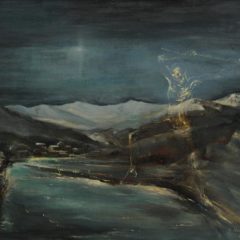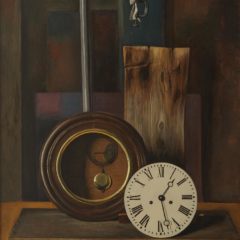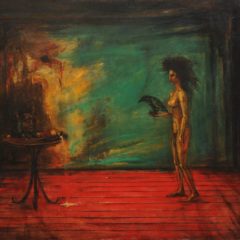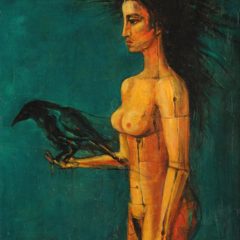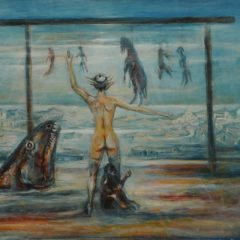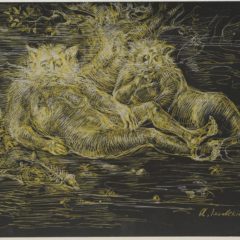When looking at the trajectory of each artist’s career, one necessarily thinks about the lasting and transient values of art within time.
Aram Isabekyan’s career spans over 40 years, during which paintings and drawings were created. He is widely acknowledged to be a distinguished representative of contemporary Armenian art, both in Armenia and abroad.
On his way to artistic quests and self-fulfillment, the artist had to overcome the impact of his talented parents, artists Edward Isabekyan and Arpenik Nalbandian’s direct and powerful art and find his own distinctive style. However, talent is not sufficient to achieve it without devotion, painstaking and consistent work.
Laconism, solid and precise compositional structure, completeness of treatment of separate elements as well as a saturated colour scheme is typical of the artist, who entered the artistic scene in the 1970s. These features reveal peculiarities of Aram Isabekyan’s pictorial thinking, artistic style and the wide range of interests. In the course of time they have been enriched and crystallized, becoming an integral part of Isabekyan’s artistic system.[expander_maker id=”1″ more=”Read more” less=”Read less”]
Already in early compositions and still lifes, characteristics of the artist’s creative individuality and modern artistic thinking account for the fact that the portrayal of his thoughts and emotions often has allegorical and symbolic meaning. It stems from the unique artistic interpretation of renunciation of evil phenomena inherent in the society and human relationships, as well as the imposed fake values of the 20th century.
In an interview Aram Isabekyan has precisely defined his belief and life philosophy his art is anchored in: “The artist is the mirror of the people’s spirit and lifestyle; his works should reflect life, the wisdom and spiritual wealth of his people.” These are the criteria of his art.
Renouncement of the negative phenomena of reality, the loss and suffering that our people went through not so long ago, are reflected not only in real nightmarish works, but also in allegorical paintings and prints, such as: Remember 1937 (1996), Illusory Peace (1996), The Clock from Igdir (1983), Feast of the Hyenas (1989), Dream (1991), Surrealistic Wisdom (1996), The Mightiest (1996), Witches (1999), Mutant (1997), Couple of Lionmen (2003).
The heroes of this cycle are beyond time and setting; they are disguised, fettered, often cruel and horrifying, with a cold stern look, concealing their emotions behind a luxurious mask. However, they do reveal complicated psychological and emotional conditions.
The objects and animals surrounding them (a hyena, a raven, a cat, a parrot in a birdcage and a jug) make the vision of enigmatic atmosphere complete through symbolic interpretation constructed on red, green, saturated blue shades, silver, turquoise and milky, juxtaposed with black, dark contours, anxious and jagged articulation.
Along with deliberate unreal subjects, the artist creates a mysterious world of sublime and harmonious feelings, where the heroes are overwhelmed by lyrical and melancholic feelings and dreaminess at the same time (Devotion, 1992; Chevalier, 1994; Day Watch, 1996; The Knight and the Woman, 2002). The artist uses a metaphorical language and restrained expressive means in order to show his ideas on love and devotion, chivalry and honesty.
These works bear certain similarities to the artistic conception of metaphysical and surrealistic movements, which relates to the subconscious.
When considering Aram Isabekyan’s art within this context, characteristic features of his art – i.e. vigorous strokes, perceptions and interpretations of universal problems and values, beauty of life, long-lasting interpersonal attitudes – become apparent.
The artist has worked out his own “formula” of life, progress, feminine beauty and charm. He presents the viewer various manifestations of luminous, tender (Family, 1979; Ira with Child on the Couch, 1982) and enigmatic images of the woman (Nude with a Parrot, 2001; The Beauty, 2002; A Cup of Coffee, 2003; Girl with a Hat, 2004; Mistress, 1999). The female heroes of numerous compositions and portraits have beautiful expressive traits, luminous, proportional and perfect figures imbued with mysterious solemnity and sense of dignity.
Still lifes stand out with their rich subject matter, variety of characters and motifs, as well as exceptional artistic quality. Some of them are a link between past and present events (The Clock from Igdir, 1983; Armenia in 1988, 1988; Letter from America, 1988; My Path, 1993). As an Armenian intellectual and citizen, the artist adopts a distinct attitude towards these events. Some works are travel recollections and impressions, where the viewer’s attention is shifted from fine objects and luxurious, colourful masks to a relevant cultural environment (Still Life with an Egyptian Statuette, 1997; Venetian Masks – cycle, 1999-2009; Mask and Bottles – cycle, 2005-2010).
Compositions with masks are of particular interest. By frequently reverting masks, the artist renders various mood and feelings. Some of the still lifes reflect his perception of beauty of nature and the surrounding world (In the Studio, 1993; Bread and Wine, 2002; Sunflowers and Shells, 2006; Vase of Roses, 2005; My Garden – cycle, 2000-2010). The objects that appear in different paintings (books, trumpet, violin, butterfly, shells, masks, bottles and so on) reveal the artist’s predilections and interests creating, certain atmosphere where he lives and works.
Distinctive traits of the artist’s style and pictorial thinking are demonstrated in still lifes through solid compositional construction, even the illumination of objects and their relation, as well as through detailed treatment of these elements.
Owing to these features every object acquires its own meaning and even allegorical-symbolic reference, as for example, Armenia in 1988. The image of Christ hanging diagonally across the wall, the tricolor in an empty frame, the trumpet, the portrait, the vase of immortelles and the violin are interrelated and personified as a token of the years of national rebirth and struggle for independence.
When comparing still lifes of different periods, it becomes clear that the most recent ones are enriched with new subject matter and expressive artistic means, which accounts for the artist’s experience and reappraisal of the significance of nature, homeland and the existence. Interior still lifes and trim garden scenes adorned with flowers are flooded in sunlight.
Deep, dark colours, flat, smooth strokes typical of previous still lifes are now replaced by brighter and lighter colours, applied in transient, expressive and weightless brushstrokes.
A peaceful and harmonious mood, as well as the artist’s spontaneity to admire the beauty of nature predominate in still lifes.
The artist’s thoughts and feelings about the relation man-nature are more completely apparent in landscapes. The artist has a predilection for cosy sites of his homeland, which are hardly noticeable at first sight, such as: lake Sevan and its rocky shores, a rose hip bush with red berries, an outskirt of a mountain village and so on (paintings and prints: View from Dilijan, 1993; At Gosh Village, 1994; Old Mill in Byurakan; Rose Hip Bush in Sevan, 2004; Cloudy Day. Sevan, 2006; My House in Ashtarak, 2009).
Landscapes are notable for the variety and depth of thoughts imbued with an idyllic poetic quality and extraordinary concentration of emotions that create a contemplative mood. Nature in Isabekyan’s art is not merely a depiction of separate places and motifs, but rather a generalized representation. Most notably the latter appears in compositional works, still lifes and portraits as independent subject matter (E. g. paintings and prints of the Chivalrous – cycle; Salome, 1997; My Path, 1993; Renaissance, 1995 and so on).
Thus, a mountain range recalling the Armenian Range – which is the continuation of the Masis cycle – stretches toward the depth of the picture, vanishing behind the trees, or appears in a bright silver haze. The landscape is enriched with architectural elements, such as: a refined arch and a dome. These are generalized representations not resembling a temple or church. This feature enhances the symbolic reference of the picture.
Isabekyan’s portraits are of significant importance, since he applies a new approach towards the interpretation of classical principles of Armenian and world portraiture. It is demonstrated through restrained and solid composition, expression of different emotional reactions and a unique artistic quality. The artist creates a gallery of portraits against neutral or conventional landscape backgrounds, which helps the viewer to immediately turn his attention to an ostensibly quiet face of a standing or seated model. With an acute eye the artist penetrates deep into his sitters’ soul, reveals their temperament and inner life. They are reserved, dreaming and happy, living in an imaginary world. Most notably the artist does not pretentiously idealize his sitters. He portrays real people, devoid of unnecessary colour and sentiments. Thus the portraits assume biographical significance best revealed in the Portrait of My Father (1995), portraits of Paravon Mirzoyan (1997), Aleksan Kirakossian (1998), Sos Sargsian (1999), Archbishop Navasard Kchoyan (2000), cycle of self-portraits (1970,1973, 1980) and portraits of Anna (1989, 1995, 1997, 2008).
Portraits of the artist’s daughter Anna are remarkable for their compositional construction and the variety of emotions. Artistic embodiment of human love and joy, awakening and beauty immanent in the portraits, created over years, appeals to the viewer owing to the spontaneity of emotions, the artist’s perception of eternal life and intensity of generalizations.
Drawings occupy a separate place in A. Isabekyan’s art. His wide range of interests is apparent here, too. The use and combination of different techniques (charcoal, pencil, sanguine, pastel, Indian ink and watercolour) result in complete compositions, portraits, landscapes, as well as sketches which testify the artist’s individuality and high professionalism and bear the seal of free creative thinking.
The artist’s constant quest and analytical thinking aim at self-discovery and new demonstrations of man-nature concept, foretelling the next stops of his creative route in contemporary Armenian painting.
Knarik Avetissian[/expander_maker]

